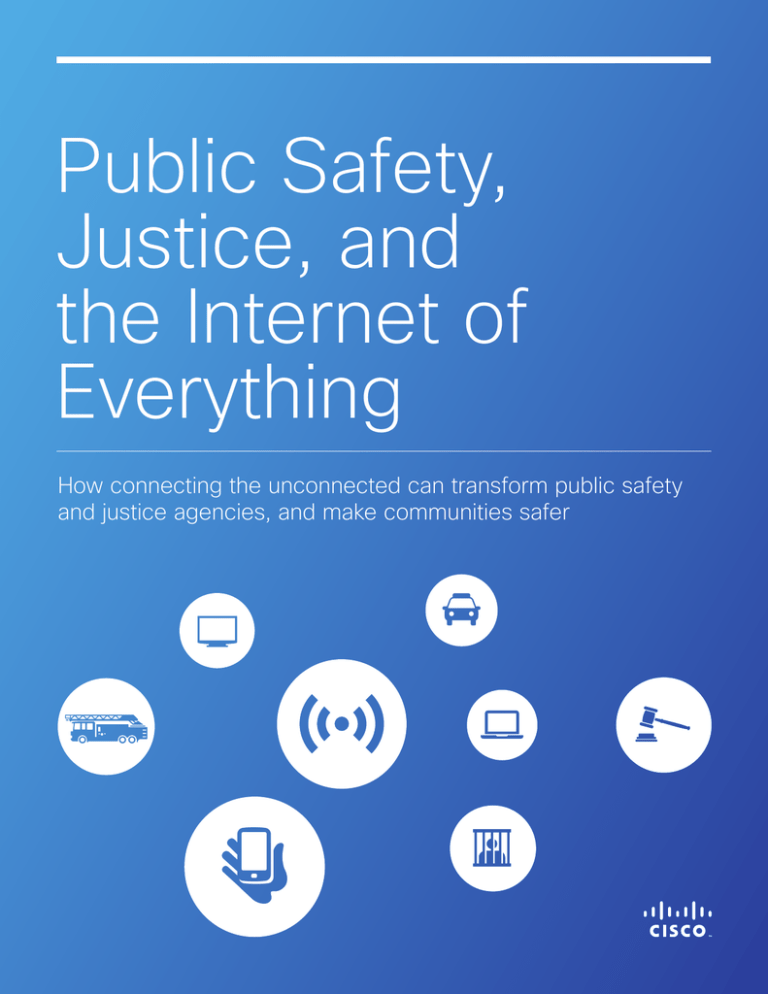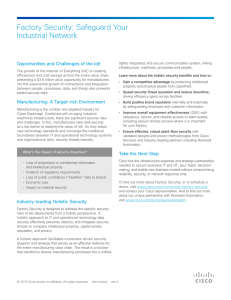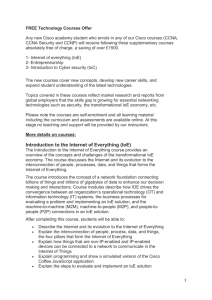
Public Safety,
Justice, and
the Internet of
Everything
How connecting the unconnected can transform public safety
and justice agencies, and make communities safer
1
© 2014 Cisco and/or its affiliates. All rights reserved.
Table of Contents
2
3
Abstract
3
What Is the Internet of Everything?
4
Public Safety Trends and Challenges
5
IoE for Public Safety
6
Key Technologies and Applications in Public Safety and Justice
6
Law Enforcement
7
Emergency Response
8
Corrections
9
Courts
10
11
Key Factors Related to IoE in Public Safety
11
Getting Started
12
Conclusion
National Security
© 2014 Cisco and/or its affiliates. All rights reserved.
Abstract
This paper examines how the increasingly ubiquitous connectedness of our IoE world can help provide
public safety and justice agencies with new opportunities to meet and overcome the challenges they
face. It specifically examines this topic through applications in law enforcement, emergency response,
corrections, courts, and national security, and shows how IoE can help transform agencies to better
protect citizens and make communities safer. Finally, this paper will provide recommendations on strategy
implementation to enable agencies to take the next steps.
What Is the Internet of Everything?
The Internet of Everything (IoE) is a continuous interaction among people, processes, data, and things. Sensors, networks, and
smart devices are ubiquitous, providing a torrent of streaming data, or “data in motion.” Cisco is helping customers and strategic
partners take advantage of the entire potential of IoE to achieve radical results across all sectors and industries. Indeed, IoE
is capable of helping public safety and justice agencies increase cost efficiency, improve safety and security, provide better
response times, and increase productivity.
As shown in Figure 1, the right combination of technology,
process, and culture is required to unlock the full value of IoE.
Figure 1.
Equal Parts Required for Success
People
Today, most people connect to the Internet through their
devices, such as PCs, tablets, televisions, and smartphones,
as well as through social networks, such as Facebook.
According to the technical research firm Gartner, in the future
people will become connections on the Internet and support
two-way data transmissions. Police, corrections, and other
public safety personnel may be tracked with sensors placed
on the skin or sewn in to clothing to transmit vital signs and
other information and thus becoming nodes on the Internet to
both transmit and receive information.
Technology
Business / Technology
Architecture
Cisco
Process
Process plays an important role in how each of these entities
(people, data, and things) works with the others to deliver
value in the connected world of IoE. With the correct process,
connections become relevant and add value because the right
information is delivered to the right person at the right time
in the appropriate way. Imagine a commander being able to
seamlessly route information, even across disparate agencies,
in real time as an incident unfolds. Processes are what enable
information sharing and interoperability for better situational
awareness.
Process
Culture
Simplified
Operational Excellence
= Innovation
3
© 2014 Cisco and/or its affiliates. All rights reserved.
Data
With the Internet of Things (IoT), devices typically gather
data and stream it over the Internet to a centralized source,
where it is analyzed and processed. With IoE, instead of just
reporting raw data, connected things will send high-level
information back to machines, computers, and people for
further evaluation and decision making. This transformation
from data to information in IoE is important because it enables
public safety and justice personnel to make faster, more
intelligent decisions.
“The Internet of Everything brings together
people, process, data, and things to make
networked connections more relevant and
valuable than ever before.”
Ken Boal
Vice President of Cisco, Australia and New Zealand
Things
This group is made up of physical items such as sensors,
consumer devices, and enterprise assets that are connected
to the Internet and each other, radio-frequency identification
(RFID), and actuators. An actuator is an object that makes
an action. For example, an actuator can turn off an engine
or a light, or start a process to control a more complex
system. In IoE, these things will sense more data, become
context-aware, and provide more experiential information to
help people and machines make more relevant and valuable
decisions.
Public Safety Trends and Challenges
Public safety and justice agencies are under pressure to
modernize and to cut government costs by streamlining
operations while making data more accessible to law
enforcement, corrections departments, emergency
responders, courts, and national security agencies.
Police now are turning to technology for force multipliers
to compensate for recent reductions in staff as department
budgets have been drastically reduced by budget cuts in the
past 10 years. Results from an International Association of
Chiefs of Police and Major Cities Chiefs Association survey
estimated 53 percent of U.S. counties are working with fewer
staff today compared to a decade ago.
At the same time, public safety is trying to determine how
video and other multimedia can be shared across publicsafety agencies. Disparate communications systems and
network technologies that are currently in place create
roadblocks to interoperability.
Corrections and court systems need to use video on mobile
devices to provide educational and telemedicine services
to prisoners to reduce recidivism and to improve safety.
Currently, this requires moving prisoners across facilities, or
even offsite, to provide the federally mandated services to
all prisoners, including access to education, healthcare, and
mental-health services.
4
© 2014 Cisco and/or its affiliates. All rights reserved.
Emergency responders at an incident scene are looking
for new ways to access data before they enter a disaster
area, while incident commanders seek to track emergency
responders and their vehicle locations and conditions.
National-security agents also are looking at technology to act
as a force multiplier and move data to and from field agents’
mobile devices. Currently, many investigators in the field must
determine in person a specific threat when a device, such
as an unmanned ground sensor, is activated. Agents seek a
network of technologies that can access data and video, and
transmit that information quickly to decision makers.
The top priority for agencies is secure data transfer. Given
the current initiatives around network security and other
threats facing public safety networks, it becomes even more
important to secure networks from nefarious Internet attacks.
IOE for Public Safety
The IoE brings together people, process, data, and things to
make networked connections more relevant and valuable.
This combination can enable public safety personnel to move
critical video data from incident commanders to field officers,
giving public safety agencies and their personnel access to
real-time, multimedia data in the field.
As seen in Figure 2, IoE has the potential to increase the
effectiveness of public safety agencies while promoting
efficiency, lowering costs, enabling rich video, and helping to
protect responders from harm.
Figure 2.
The IoT component is a network of physical objects that can
sense and communicate data, and is accessed through the
Internet. The technology enables users to take action based
on intelligent data. The advent of the IoT has expanded
dramatically the scope and capabilities of connected
cameras, which now can be used as intelligent platforms to
deliver gains in operational efficiency, situational and acoustic
awareness, and forensic investigations. The evolution of video
analytics, such as facial and license plate recognition, as well
as audio analytics, has enhanced the ability of IoT-enabled
cameras to deliver superior insights into all application areas,
from safety and security to operational intelligence.
2014
Current Operations
2018
Potential with IoE
Static data
Rich video data
With IoE, in conjunction with the IoT platform, public safety
officials can move sensitive information with mobile devices
over a secure network environment because IoE’s intelligent,
secure, next-generation networking and collaboration
capabilities connect public safety and justice agencies to
their data through a single and secure solution. An IoE-based
network can take advantage of a multilayer architecture that
integrates the best-of-breed capabilities to deliver a secure
mobile architecture and a comprehensive solution to protect
against most security risks.
Personnel physically
on scene
Personnel use mobile
technologies to
safeguard lives
Disparate systems
means users can’t
access or share data
Interoperability
across systems
High cost and
inefficient
Creates common
operation picture and
operational efficiencies
IoE also provides enhanced interoperability, situational
awareness, mobility, and overall security through nextgeneration computer, network, collaboration, and storage
applications. With the IoE’s secure cross-architecture
approach, public safety and justice leaders can rethink how
they deliver and safeguard critical services and assets during
unprecedented budgetary challenges, all while increasing
workforce productivity, enhancing operational efficiencies, and
driving down costs.
Public safety and justice agencies, just like all other agencies
and private businesses, are potentially at risk of being hacked,
no matter whether in an urban or rural area. IoE can help
ensure data is available, yet confidential, when needed, with
the owner of the information deciding which people, groups
or agencies may have access to it. However, it is critical to
remember that agencies should make sure they have a strong
security policy in place and take proper precautions.
5
© 2014 Cisco and/or its affiliates. All rights reserved.
Key Technologies and Applications in Public Safety and
Justice
IoE has myriad applications for public safety and justice agencies, including law enforcement, emergency response, corrections,
courts, and national security. Because IoE is a flexible network, innumerable applications are available for public safety agencies
seeking access to data to streamline operations and better safeguard personnel.
Law Enforcement
IoE can be used as a force multiplier to help supplement labor
cuts in many law-enforcement budgets. Technologies used
as force multipliers can safeguard public-safety personnel
by creating better situational awareness and by supporting
interoperability.
Video and other situational data helps dispatchers and officers
make decisions based on information instead of going into
a situation blind, while also having access to video data for
investigations and training. In addition, IoE officers in the field
can become mobile offices, using tablets to submit incident
reports that connect them to judges from their vehicles. IoE
also supports video arraignment to reduce costs and enhance
safety during detainee transport, remote court appearance
to eliminate travel and delays, and remote interpretation to
conduct interviews immediately in the field, no matter the
language required.
By using the IoE, law enforcement agencies can have
quick access to information at any time from virtually any
place, wired and wireless, enabling real-time collaboration,
incident response, investigation, and resolution. Integrating
remote video and real-time collaboration at all levels of law
enforcement allows agencies to:
• Control costs
• Manage evidence
• Reduce response time
• Decrease crime
6
© 2014 Cisco and/or its affiliates. All rights reserved.
“IoE lets police officers send and receive
real-time video data from the field, greatly
improving situational awareness.”
Chief Bob Stanberry (retired)
Business Development Manager for Connected Justice and
Public Safety
Case Study:
Florida DHSMV In-Car Video Deployment
The Florida Department of Highway Safety and Motor Vehicles
(DHSMV) uses IoE to deploy in-car video on police car
dashboards. These video systems enable officers to collect
video footage for evidence in trials involving DUI charges and
resisting arrest, as well as other situations. Should a citizen
file a complaint about an officer’s conduct during an arrest,
the video footage can be used defensively by the trooper to
prove that the arrest was conducted properly.
Before installing the Wi-Fi antennas in designated areas,
the upload time for video footage was about 3 hours. By
deploying Cisco-engineered access points and antennas
throughout the state, upload times were reduced to only 20
minutes. This saved the department $1.1 million for the year
in overtime due to slow upload times.
Emergency Response
Effective management of emergency response vehicles,
whether ambulances, fire trucks, or police cars, is critical to
the safety and well-being of citizens. If emergency vehicles
are out of service or unable to respond quickly, it can be
a matter of life or death. For emergency responders, IoE’s
ubiquitous connectivity can be used to develop applications to
track emergency response assets through connected vehicle
technologies. In addition, ruggedized routers, switches, and
surveillance cameras can be leveraged to help emergency
response and public safety vehicles:
• Comply with safety mandates and regulations
• Maintain constant contact with dispatchers and fleet
managers
• Transmit live telematics data for proactive maintenance of
vehicles
• Use a GPS device to guide them to the scene by way of
the fastest and most direct route
• Use vehicle-to-infrastructure (V2I) communication so
vehicles can communicate with traffic lights, rail crossings,
traffic cameras, and roads
Also, high-resolution monitors can be loaded on emergency
response vehicles to provide comprehensive intelligence
and emergency management capabilities through multiple
perspectives using video and sensor information. Images
captured by first responders, and even drone-based video
cameras, can provide real-time situational awareness back
to commanders and headquarters, which can help incident
commanders manage resources.
In addition, users can monitor and show live GPS tracking of
each vehicle responding to an incident and visually track their
location on a color-coded interactive map using geofencing to
map safety areas. First-responder vehicle fleet managers also
can be notified immediately when accidents occur or when
speed thresholds are exceeded.
Use Case:
Intelligent Networking of Emergency Vehicles
and Their Surroundings
An alarm sounds in Engine House 23, alerting firefighters to
a factory fire in an industrial park with a potential hazardous
materials (hazmat) alarm. As they race towards the fire, a rail
crossing equipped with a sensor triggers an audio and visual
alert in the truck to notify the driver that a train is crossing
at an intersection on their route. The fire truck driver quickly
diverts the route to maintain response time, saving critical
minutes.
As the truck approaches the fire, it receives data from the
cloud about the factory, the number of occupants, and the
location of nearby fire hydrants. Environmental air sensors in
the industrial park can send live updates to firefighters to help
them assess the area and identify potential dangers.
With many first responders racing to the scene, sensors in
nearby traffic lights are triggered to stop opposing traffic
safely, so first responders can respond as quickly as possible
without endangering themselves or the public. Data is sent
wirelessly over the cloud to fire, police, nearby hospitals, and
hazmat dispatchers to prepare other first responders and
medical personnel.
The dispatch center uses a fleet management system to
track the location of all vehicles, which are seen as moving
dots on an interactive screen. Vehicle sensors monitor oil
and tire pressure, and fluid levels for proactive maintenance
to keep more emergency vehicles in service while sensors
communicate with mass transit buses so they can alter routes
to keep on schedule and minimize traffic near the scene,
which helps to protect first responders and passengers.
7
© 2014 Cisco and/or its affiliates. All rights reserved.
Corrections
Corrections organizations can use IoE to streamline
collaboration tools. These tools can help corrections facilities
processes by increasing staff improvement services while
decreasing costs, increasing staff and prisoner safety, and
reducing transportation costs and risks through controlling
contraband, facilitating visitations, addressing overcrowding,
and controlling costs. Collaboration technologies can use IoE
to reduce the need for inmate transfer and to provide more
effective services to inmate populations that help corrections
personnel to:
“IoE supports collaboration across jail,
court, and police systems all securely via
the cloud.”
Commissioner Daniel Stewart (retired)
Senior Justice Advisor
• Address overcrowding
• Control contraband
• Facilitate visitation
• Improve inmate management
• Increase staff and prisoner safety
• Reduce transportation cost
• Save money
Collaboration tools can help corrections facilities improve
services while decreasing costs and security risks through:
• Education: Provides distance learning opportunities for staff
and inmates at a fraction of costs involved with traditional
face-to-face education
• Remote interpretation: Facilitates faster response to
medical or legal problems, or inmate management with
immediate access to interpreter services
• Remote arraignment and appearance: Provides instant
access to court and counsel without transport security
concerns
• Remote visitation: Allows counsel and family members
face-to-face interaction without physical security and
contraband concerns
• Telehealth: Provides remote access to practitioners and
specialists, and emergency evaluations to inmates, without
requiring inmate transfers
8
© 2014 Cisco and/or its affiliates. All rights reserved.
Case Study:
California Correctional Health Care Services
The California Correctional Health Care Services (CCHCS) is
using the universal connectivity of IoE to improve healthcare
services in California prisons and increase patient access to
specialty care, mental healthcare, and primary healthcare.
IoE connectivity enables CCHCS to operate a telemedicine
program, as well as to provide virtual specialty-care services
to California inmates. This program has enabled collaboration
among more than 7,000 California healthcare workers and
prison staff in 33 correctional facilities, as well as CCHCS
headquarters.
Cisco installed 81 Cisco TelePresence® Clinical Presence
System endpoints to virtually connect staff and patients
to specialists through video, audio, and other sensory
technologies, such as stethoscopes. The deployment now
streamlines delivery of specialty healthcare to 166,000
inmates throughout California.
Courts
IoE-based court and justice solutions can streamline court
processes by providing face-to-face collaboration without the
time and cost of travel, or the need to move inmates or bring
in live interpreters. By improving collaboration and increasing
safety and security, it is possible for courts to:
• Control costs
• Increase the pace at which cases are decided
• Reach beyond courthouse walls, instantly
Remote adjudication can speed up court services and improve
citizen access and satisfaction. Remote testimony can enable
courts to scale resources and experts easily and effectively
while improving public safety and reducing the need to
transfer inmates. In addition, remote interpretation can take
advantage of a central pool of interpreters, eliminating travel
costs, improving access to specialized languages, and
eliminating delays.
Case Study:
Dallas County Public Defender Video
Deployment
Dallas County operates the largest public defender office in
the state of Texas with 94 lawyers who try more than 45,000
cases annually. The county needed to streamline operations
for the courts, enhance productivity, and ensure that all
activities were aligned with the state’s Fair Defense Act, which
requires public defenders to communicate with clients within
24 hours of being appointed.
The county took advantage of IoE’s potential by installing
a robust IP network backbone capable of supporting video
applications and deploying 200 video endpoints for remote
court appearances and other types of video in remote
locations. The system is used to arraign prisoners in the jail
and communicate with the Justice of the Peace Courts and
the Dallas County Community Supervision and Corrections
Department.
“Once you have the infrastructure in place,
you can use it for myriad applications, such
as arraignment, testimony, or interpretation
services.”
Judge Boyd Patterson (retired)
Dallas County Chief Magistrate and Cisco Business
Development Manager
9
© 2014 Cisco and/or its affiliates. All rights reserved.
National Security
Federal security agencies can better carry out their missions
through IoE. Regions with few resources and personnel in the
field can access real-time data for better decision making on
how to deploy available personnel resources effectively. IoE
applications provide improved situational awareness and act
as a force multiplier. In addition, information derived from IoEconnected sources provide a common operating picture to
save time and lives.
IoE applications help national security agencies better analyze
information from field sensors and other technologies and get
that information to a mobile U.S. border control agent, who
can then determine whether a sensor is tripped by a person
or by animals moving along the border. Unmanned aerial
vehicles (UAVs), armed with video and night-vision payloads,
can be deployed to capture data before agents are deployed,
which provides a common operational picture to better
safeguard the lives of border control agents.
10
© 2014 Cisco and/or its affiliates. All rights reserved.
Case Study:
National Safety Agency’s Connected ESIC
Vehicle
The National Safety Agency, an Australian not-for-profit
research and development organization and a leader in the
development of solutions for emergency management, has
worked with Cisco to design a prototype vehicle known as
the Emergency Services Integrated Communications (ESIC)
vehicle. The goal of the ESIC vehicle is to provide a mobile
command and control capability to address all hazards and to
link all agencies involved in an emergency situation.
When activated, the self-contained ESIC vehicle meets
these demands by combining all the necessary technology
for emergent services with the ability to travel in proximity to
the incident. After it is at the incident scene, the ESIC vehicle
is completely operational in 15 minutes. Trained operators
immediately can begin to manage and monitor the incident.
Key Factors Related to IoE
in Public Safety
Getting Started
Cybersecurity and Data Integrity
If you are a public safety decision maker, take the following
steps to begin creating an IoE strategy:
IoE security will become an enormous issue across all
markets, particularly in public safety. Information must be
available, yet confidential, when needed, with the owner of
the information deciding which people, groups, or agencies
may have access to it. Embedded devices will help create
complex networks of people and things, and such devices
likely will create new relationships among people and
computers.
Integrity of data must be assured, as well as its accuracy and
authenticity. Success will be predicated on an open platform
that allows all partners working together to use the same
baseline technologies.
A balance must be maintained between understanding the
positive impacts discussed in this paper and generating
awareness about the risks to privacy and security. Public
safety and justice agencies will need to have a better
understanding of the risks of IoE, as well as ways to mitigate
those risks. Personal and communal data will need to be
treated differently, and the individual’s privacy will have to be
respected.
1.Identify the IoE capabilities your organization currently has
in place.
2.Seek and incorporate in your strategy the complementary
insights of public safety personnel and Cisco IT leaders.
3.Identify major IoE opportunity areas and establish an IoE
public safety vision that includes future needs.
4.Reach out to public safety organizations on local, regional,
state, and federal levels to share the benefits of IoE
platforms across governmental borders.
5.Build an IoE culture by helping public safety personnel
determine the possibilities of connecting data to mobile
devices used in the field.
6.Develop a 5-year plan to map out future applications,
because the IoE is flexible enough to grow with public
safety users’ requirements.
Government Policies
Policies that encourage adoption of technology in public
safety are crucial. Such policies must include sound change
management practices among the agencies to reduce
the barriers to technology adoption and increase its scale.
Governments will continue to have a policymaking and
regulatory role in relation to IoE so there must be a strong
partnership, between them, public safety agencies, and
technology providers, such as employing Cisco’s IT experts to
help build out long-term technology strategies.
11
© 2014 Cisco and/or its affiliates. All rights reserved.
Conclusion
As the leader in world-changing technology for more than
20 years, Cisco is uniquely positioned to improve every day
experiences for court administrators, judges, other court
personnel, law enforcement and public safety officers,
correctional facility officers, and many other stakeholders.
Cisco also offers the justice community a secure, resilient
network backbone that enables decision makers to be more
responsive and agile by removing barriers to communications,
facilitating information sharing, promoting collaboration, and
supporting innovation.
There is tremendous value in connecting the unconnected
with intelligent networks across public safety and justice.
This paper demonstrates IoE’s potential impact on protecting
citizens and making communities safer.
However, to realize the benefits of connecting people,
processes, data, and things, reliable connectivity and
continuous access must be guaranteed. Additionally, for IoE to
be accepted, both policymakers and public-safety leadership
must be well-prepared to work with technologists to improve
services to their constituents.
For more information, go to
www.cisco.com/go/uspublicsafety.
In collaboration with:
Cisco and the Cisco logo are trademarks or registered trademarks of Cisco and/or its affiliates in the U.S. and other countries. To view a list of Cisco trademarks, go to this
URL: www.cisco.com/go/trademarks. Third party trademarks mentioned are the property of their respective owners. The use of the word partner does not imply a partnership
relationship between Cisco and any other company. (1110R)
12
© 2014 Cisco and/or its affiliates. All rights reserved.



![Project Title Information sheet for [name of adult participant group]](http://s2.studylib.net/store/data/012661992_1-ca2e4a2b9452dea0c78f27fbbcf43de5-300x300.png)

